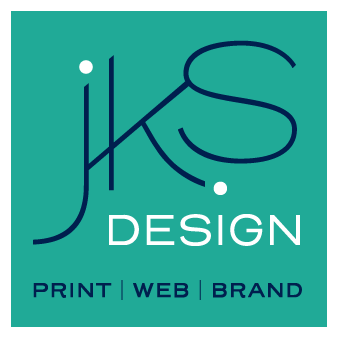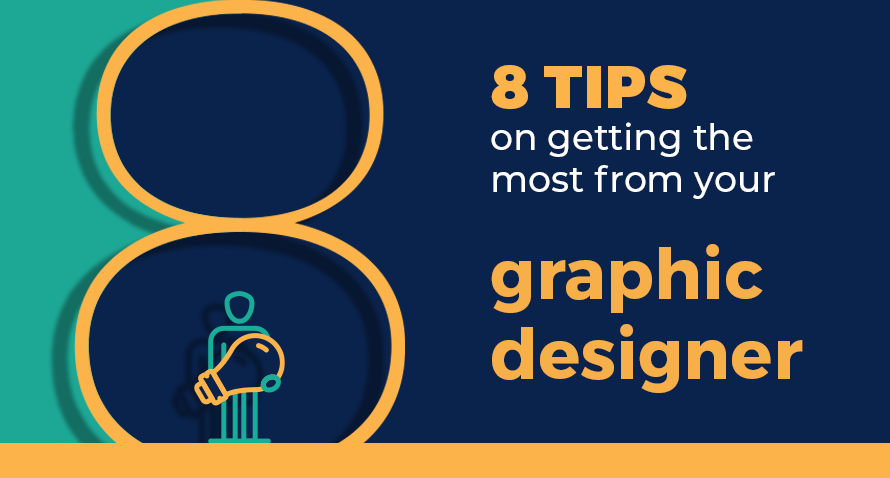
8 tips for getting the most from your graphic designer
In this post, I outline 8 tips which will help you get the most from your relationship with your graphic designer which will be beneficial to you both.
Trying to get – and keep – the attention of today’s short attention span, hyper scrolling human is becoming ever more difficult in our fast-paced world. If you haven’t hooked them in seconds, they’ve moved on to the next website, the next channel, the next magazine page, the next product on the shelf…
The human brain processes images much faster than text, some say within milliseconds.
Text is also vital to ‘back-up’ the message presented in the image, so the two go hand-in hand. Presenting this imagery and text in a visually pleasing, easily processed way is the skill set of the graphic designer.
Finding and working well with a graphic designer who is the right fit for your business can make a huge difference to how your company is perceived. We all make split second judgements and those first impressions are crucial. Enlist the help of a graphic designer to make those first impressions the best they can be!
Are you looking to work with an experienced, competent Graphic Designer who has worked in the design field for 25+ years? Contact me today to arrange your FREE, no obligation 30 minute chat to discover how I can help your business….

1 – Designers are not telepathic (although it’d be great if we were!)
It’s true! We are not mind-readers, although sometimes I do wish I had the ability!
When asking the client what they require, occasionally the response will be “I’ll leave that to you, you’re the designer!”. *Help!*
And I get it. Sometimes it’s difficult to know what you need or what will work but for your design project to be successful, it not only needs to (a) appeal to and engage your target market, it also needs to (b) appeal to you and your team. Buy-in by you and your team is necessary. If you’re not happy with the final design, (subconsciously) it will be difficult for you and your team to promote and utilise the design.
Any direction is warmly welcomed but ideally the more information you can give at the beginning, the better. Which is where #2 comes in…

2 – Supply a brief
No matter the project, your designer will need information. In some cases, the designer will expect you to supply a brief. In my case, I will gladly accept your brief (if you have one) but I also request that you fill in my short questionnaire which gives me most of the information I need. Depending on the project, I usually follow this up with a discovery session which can be in-person or via a virtual meeting. The more information you can give me at the outset, the better the outcome and the faster the turnaround time.
I will be looking for in-depth information but the 5 key things will be:
- WHAT? – are your design requirements;
- WHY? – the reason for the design;
- WHO? – is the target market;
- WHERE? – the final design will be used – print materials, website, social channels etc.
- AIM? – the project goal.

3 – Give examples
If you were asked to give examples of design that you have seen in the past (or recently) and liked, what would spring to mind?
Giving some examples of design that you like can help give direction in regard to your style preferences. The examples you give can be in the form of photos, screenshots, web links etc. and they don’t even need to be directly linked to your project type or intention.
For example, you may have seen a website that you liked but you require packaging design or brochure design. The medium of the design is irrelevant (in this context) as we are only referencing styling so regardless of the use (web/print), your example(s) will give your designer better direction.
It’s also extra helpful if you can explain your reasons for liking said example(s) – briefly state what you liked about it – colours, fonts, imagery, use of spacing etc.

4 – Do not let your heart (over)rule your head!
The final chosen design must have purpose, in that it will engage your target market and create the desired action – purchase, contact, enquire etc.
With that in mind, remember that your own personal preferences – when it comes to style, colour, font etc. – may not be the most appropriate for your target market.
Are you a lover of the colour pink but head up a firm of solicitors? Consider then that using the colour pink in the logo is most likely not the best option, given its playful and romantic associations! By all means mention your likes and preferences, but in the end let your designer guide you in regard to colour choice and the other fundamentals of good design.
The aim is for your target market to like (and engage with) the design. Take the advice of your designer and try not to let personal preferences affect your final decision.
That said, it is important for you to ‘be-on-board’ with the final design, so if it jars with you, relay that to your designer and work on it together to reach a practical solution.

5 – Revisions
The designer has read your brief, asked you questions and got an overview of your company and your design project. Next step is design conception. They will submit a draft design to you, ask you to review it and submit your feedback. Take your time with this. Visit and re-visit their proposed design and mull over what you like and don’t like, noting any changes you would like to make. The key is to limit the number of revisions you require rather than the number of changes.
To explain further…
Your project is a 24-page brochure with a mix of text and photographic content. Once you see the text and photos (you supplied) laid out within the design, you realise the entire project is text heavy and the text content needs to be reduced.
So, you read through pages 1-3, re-write the text content for those pages and email your designer to request these changes be made and a new draft be returned to you for review. Within a day or two, your designer has made the requested edits and emailed the revised brochure (revision #1) design to you for review. You review this revised brochure (revision #1) are happy with the edits but then realise you have yet to read through the remainder of the text content one the other pages.
‘To-and-fro’
You read page 4 to page 8, again note some edits you want, and again contact your designer to request these edits be made and another draft be returned to you for review (revision #2). Again this is done by your designer and again you review only a few pages at a time before contacting your designer.
This results in several more revisions before you are happy with both the design and content and have signed off on the project for print production.
This process of ‘to-and-fro’ edits, a few pages at a time, will slow the process thus causing delays to the project turnaround time. In turn, added costs are incurred due to the additional time spent by the designer making minor edits on several occasions. It can also lead to frustration both for the the client and the designer.
So how do you avoid this?
Try to cover as many of the edits needed within one revision request. I’m not saying you should try to cover everything within one revision, more to be mindful of giving your project a thorough proofing at each revision stage. Most designers would prefer to receive a page of edits for a single revision request than 5/6 edits requested over 5/6 revisions.
Think of your revision(s) as a cup of tea…
Scenario 1
You receive the draft design for your brochure from your graphic designer and you request 5 different section edits – i.e. 5 mugs of tea. Your designer boils a full kettle of water and makes a full pot of tea to fill 5 mugs and sends these back to you. You drink the 5 mugs of tea and decide that mug 4 didn’t taste right so you ask for another mug of tea (mug 6) to replace mug 4. Your designer boils the kettle of water and makes another mug of tea. You drink the tea and are satisfied and happy. Job done. The entire revision process takes 5 hours – 3.5 hours (5 mugs) and 1.5 hour (mug 6).
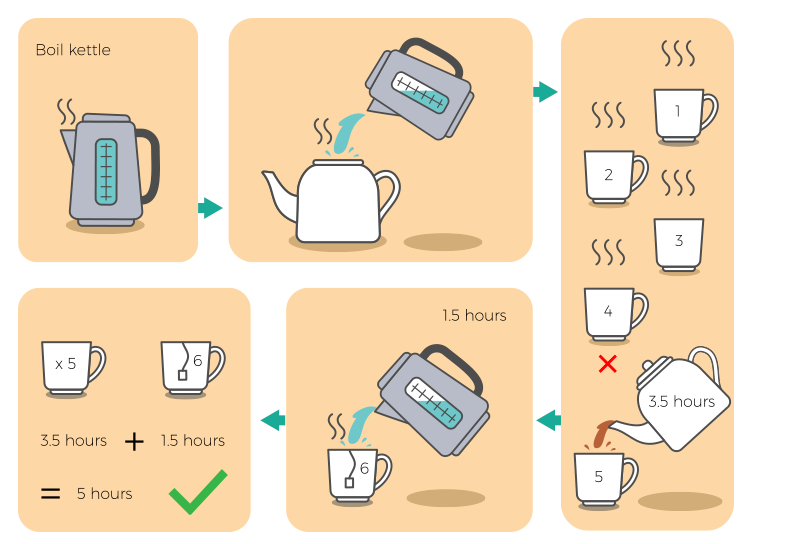
Scenario 2
You receive the draft design for your brochure from your graphic designer and you request 2 different section edits – i.e. 2 mugs of tea. Your designer boils a kettle of water and makes a half pot of tea to fill 2 mugs and sends these back to you. You drink the 2 mugs of tea and then realise you need another different mug of tea that you forgot to ask for the first time round….
Your designer boils the kettle of water and makes another mug of tea. You drink the tea and again realise you need 3 more mugs of tea and also you weren’t happy with mug 1 or mug 2 so you need re-fills for those too… Your designer boils a full kettle of water and makes a full pot of tea to fill 5 mugs and sends these back to you…. And on and on.
The entire revision process takes 10.5 hours – 2.5 hours (mug 1&2), 1.5 hours (mug 3), 4 hours (mugs 4,5&6) and 2.5 hours (mugs 7&8 to replace 1&2).
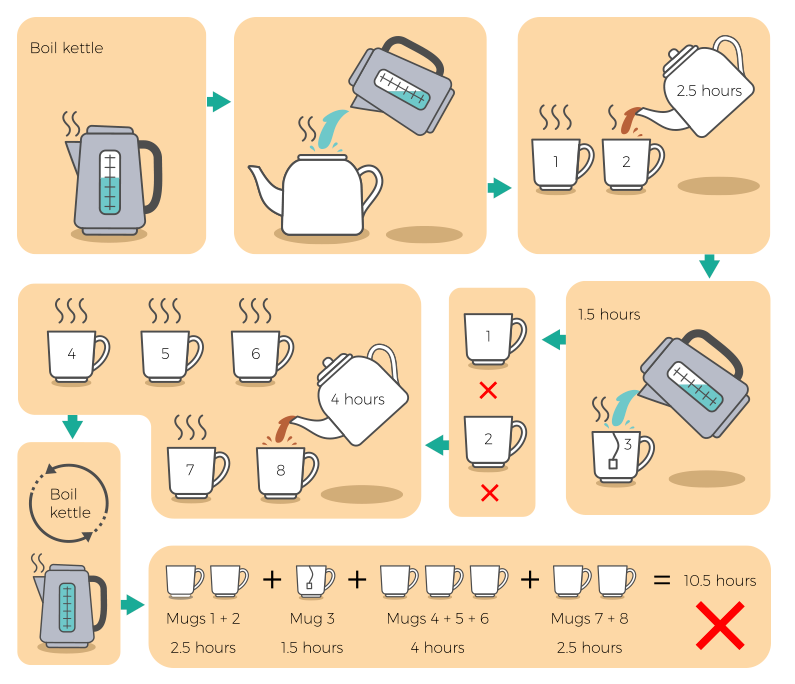
Remember, the process required per revision is:
- Locating the file (if the designer is not actively working on your project at the time of the edit request);
- Making the edit(s);
- Outputting the new proof file (new revision);
- Typing the email and sending the new revision to the client.
So with 3-4 steps per revision, it makes sense to try to reduce the number of revisions you need by sending your edits in bulk rather than drip feed.

6 – Content
In a similar way to #5, try to compile as much of your required content as possible (text, images, links etc.) before sending it to your designer for layout. Type up your text content, do a spellcheck and carefully read it through to check for missing content, correct context, grammatical errors and so on. This will help to reduce the need for revisions to correct missed typos.
Also compile and send any visual content that you wish to use. If there is something missing that you intend to get to your designer at a later stage, let them know.
Graphic design is like completing a puzzle. The designer must make the text and imagery fit together perfectly…. it is difficult to complete a puzzle when there are pieces of the puzzle missing…

7 – Research
Before choosing a graphic designer, do your research. Make sure the designer you choose can design for the purpose you need – web design, print design etc. You are producing a book… does your graphic designer have experience in editorial design? You need packaging design… can your graphic designer give examples of packaging design projects they have worked on?
You need identity design, logo design and branding…. again look for good examples of this.
Check their website and social media for examples of projects they have worked on… do you like their style of design?
Lastly look for testimonials and reviews. You can usually find these on their website or on Google if you search their business name – their Google My Business page will appear on the right of your browser window.
See screengrab below which shows you what you will see if you type, for example, JKS Design into a Google Search. The column on the right gives you details about my business. You will see a link to the Google Reviews at the top along with the number of stars each reviewer has given.
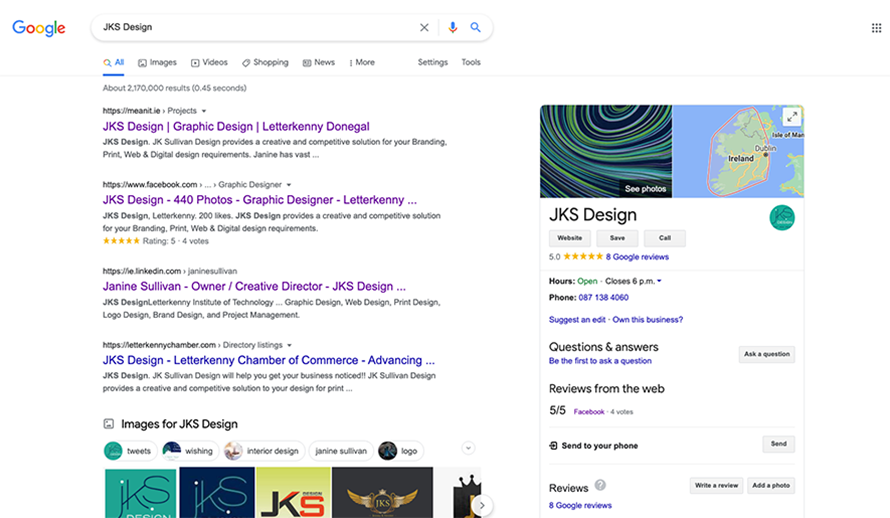

8 – Opinions
When reviewing the design given to you by your designer, it is only natural to want to ask other people what they think. However, this can muddy the waters somewhat because people, by nature, will always offer an opinion when asked!
It is nice to be asked for our opinion after all, so we gladly give it! The pitfall is that ‘their’ opinion may not be what you want to hear and may make you doubt your own thoughts about the design.
You receive the draft from your graphic designer and your first impression is yay, they’ve nailed it! You show it to your family, friends and colleagues, excited for their reaction and ask for their opinion. Cue several, usually different opinions.
Everyone wants their opinion to be the best. Some will like the draft design, some will not and some will sit on the fence. This lack of clear direction will make you doubt your own opinion, leaving you confused and deflated.
The key here is not to avoid asking for opinions but to limit who you ask and also to ask the ‘right people’ for their opinion. By that I mean the people within your business who think objectively and won’t be influenced by personal emotions, and also the people who fall into your target market.
A successful design needs to ‘sit well’ with your team (for buy-in purposes and to get them behind the brand,/product/design) and more importantly to attract and engage your target market and meet the objective of the design project as outlined in your brief.
By the way, the “yay, you’ve nailed it!” is the reaction I’m always aiming for… and although this is the reaction I get most of the time, it is not always the case. At project outset, I listen to the client, really listen, to learn what they want and how they feel about the project. This initial communication is crucial to creating the design they want and to ‘nailing it’ (or very close).
Below is a sample of some of the reviews you will see if you check out Google Reviews for JKS Design…
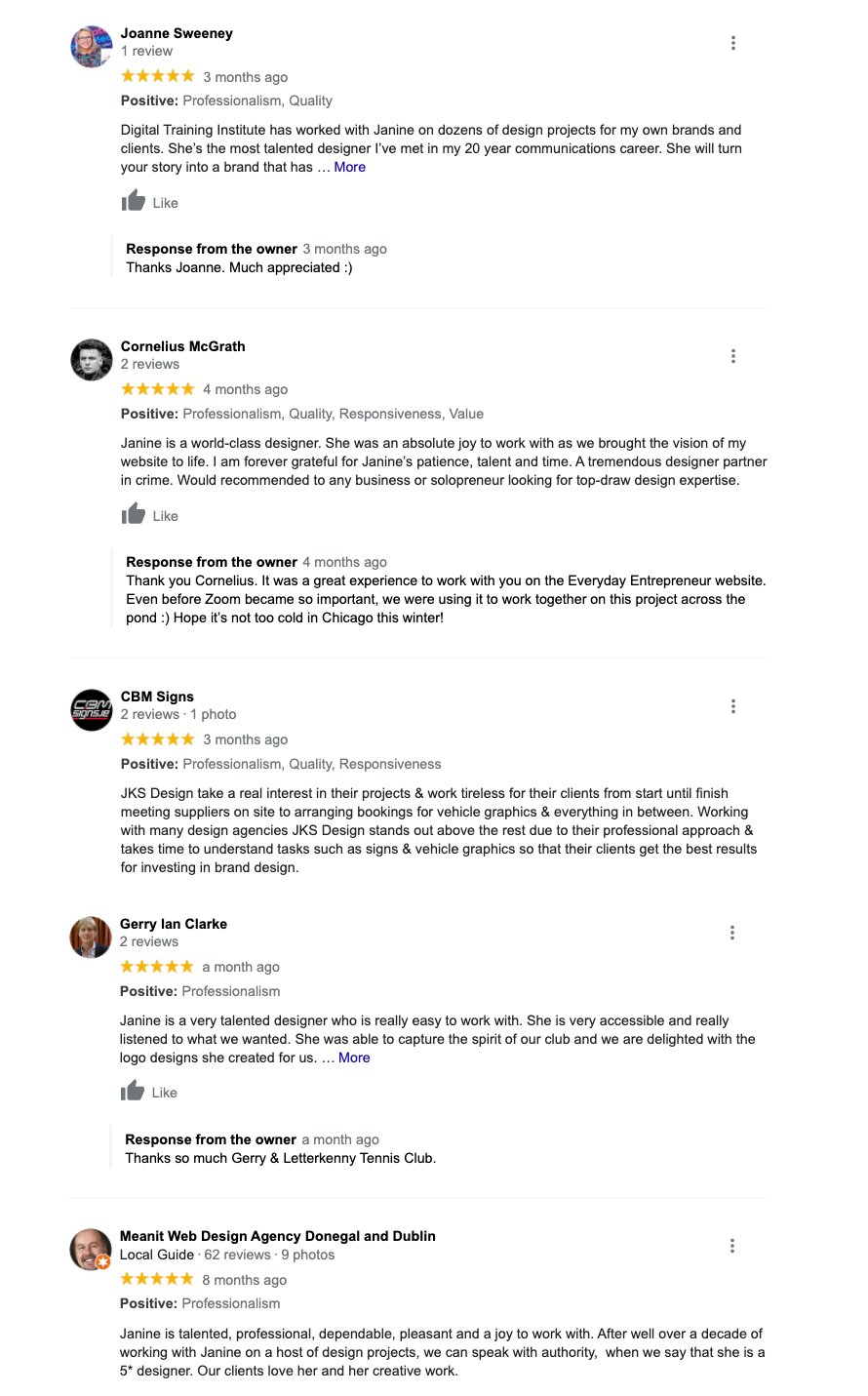
Of course there are times that I don’t ‘nail it’ first time and that’s ok too. When this happens, I work with the client to analyze the draft design to determine the elements of the design that they like and also dislike. Then it’s onto to next draft (s) until we reach the design outcome they are happy with. A happy client makes me happy!
It’s nearly the end!
You’ve got this far so I hope you found these “8 tips for getting the most from your graphic designer” helpful. Using these tips can help speed up the process and get the best result for your project. Make sure to communicate clearly what you want and what you like and don’t like. You and your designer should become a team to work together with an end goal in mind…where you both want a great outcome.
With over 20 years’ experience in print design and more than 10 years in web design, serving various business sectors both nationally and internationally, I bring a vast set of skills to the table.
Working closely with clients and liaising directly with web developers and/or print providers on your behalf, my passion for what I do and my drive to produce the best creative solution for you and your business ensures a seamless, communicative process and a positive end result.
From logos to brochures, web pages to landing pages, livery to signage and expo design, I work closely with the client, really listening to them and deep diving into their needs to deliver engaging design that lasts. My ability to design well for both print and web ensures brand consistency across all mediums thus reinforcing the brand recognition of your company at every touchpoint.
If you need great design for your business, which adds value, creates a competitive edge, drives powerful marketing results and helps your business stand out… let’s chat and see how I can help you!
